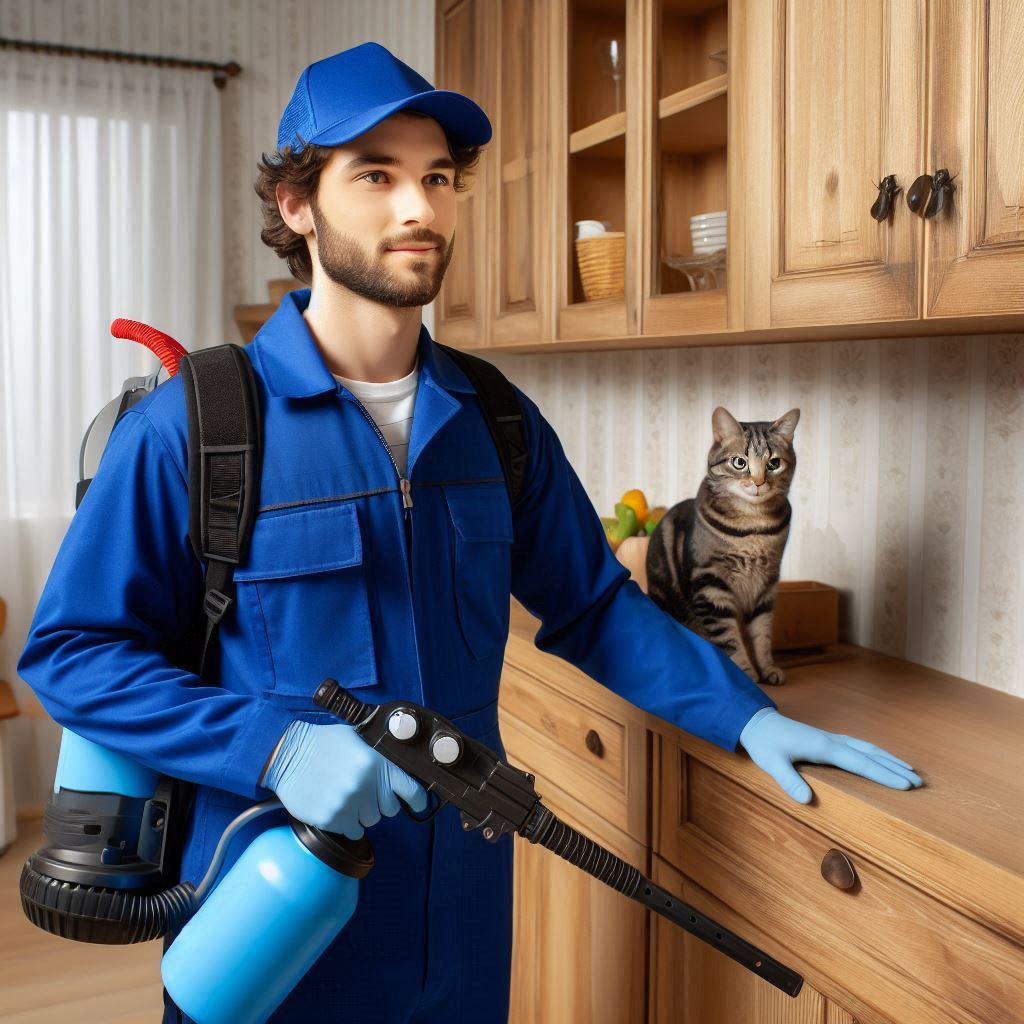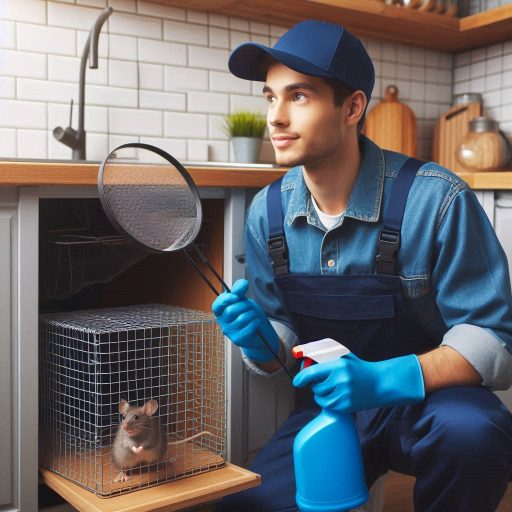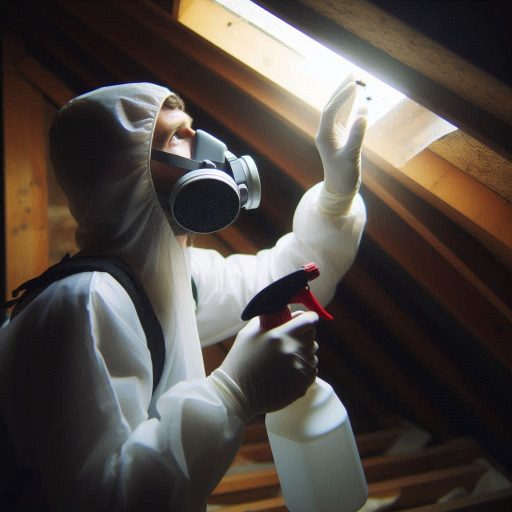Introduction
Pest control workers play a crucial role in maintaining public health and safety by managing harmful pests effectively.
Their work prevents the spread of diseases and protects homes, businesses, and the environment from infestations.
Daily Routine Overview
A typical day for a professional pest control worker includes:
- Inspection: Checking properties for signs of pests and identifying entry points.
- Consultation: Explaining treatment plans to clients and providing preventive advice.
- Treatment Application: Using sprays, traps, or baits to eliminate pests safely and effectively.
- Documentation: Recording findings, treatments, and follow-up schedules.
- Travel: Moving between different job sites throughout the day.
Skills and Qualifications Required
Pest control workers need specific skills and certifications to perform their duties efficiently:
- Problem-solving skills to identify pest problems accurately.
- Communication skills to educate clients about pest control solutions.
- Technical knowledge to handle chemicals and tools safely.
- Physical stamina for long hours of work in different environments.
- Certification and training, as required by local regulations.
Their combination of expertise and dedication ensures public spaces and private homes stay pest-free, promoting health and safety.
Morning Preparation
A professional pest control worker‘s day begins with meticulous preparation.
Setting the right tone for the day ensures smooth operations and efficient service.
Every step in the morning routine contributes to delivering safe and effective pest control solutions.
Reviewing the Daily Schedule
- Workers review their schedules to understand the tasks ahead.
- They confirm appointment times and locations to avoid delays.
- Any special client instructions are noted to ensure precise service.
- They plan routes to maximize efficiency and minimize travel time.
Gathering Tools and Equipment
- Necessary tools are assembled based on the scheduled tasks.
- Workers double-check supplies such as pesticides, traps, and bait stations.
- They inspect personal protective equipment (PPE) for safety compliance.
- Special tools, like moisture meters or fogging machines, are loaded if needed.
Vehicle and Equipment Maintenance
- Vehicles are inspected to ensure they‘re ready for the day‘s demands.
- Workers check tire pressure, fuel levels, and fluid levels.
- Equipment, including sprayers and ladders, is tested for functionality.
- Cleaning or minor repairs are done to keep everything in top condition.
Starting the day with an organized approach allows pest control workers to focus on the job.
Proper preparation ensures safe, fast, and effective services for every customer.
This structured routine guarantees they‘re ready to tackle any infestation they encounter.
Read: How to Balance Work and Personal Life in Childcare
Inspection and Assessment
Visit Client Locations to Inspect for Pest Infestations
Professional pest control workers begin their day by visiting client locations to inspect for pest infestations.
Upon arrival, they greet the client and discuss the reported issues.
This initial conversation helps gather essential details about the pest problem.
The worker asks targeted questions to understand the client’s specific concerns better.
Armed with this information, they can conduct a more focused inspection.
During the visit, the pest control worker carefully examines both the interior and exterior of the property.
They look for signs of pest activity, including droppings, nests, and damage.
They also check common hiding spots, such as cracks, crevices, and dark corners.
This thorough approach ensures they don‘t overlook any potential infestations.
Identify the Type of Pests Present and the Extent of the Problem
Next, the pest control worker identifies the types of pests present at the location.
Each pest has unique characteristics and behaviors, which helps in accurate identification.
They utilize their expertise to determine whether they are dealing with rodents, insects, or other pests.
Identifying the specific pest species is crucial for developing an effective control strategy.
As the inspection progresses, the worker evaluates the extent of the infestation.
They assess how many pests are present and how widespread the issue is within the property.
This evaluation allows the pest control worker to gauge the severity of the problem.
Some infestations may be localized, while others could span multiple areas of the property.
Understanding the extent of the problem is essential for planning the appropriate treatment.
It also helps in managing client expectations regarding the time and resources needed for effective pest control.
Assess Any Potential Risks to Customers and the Environment
After identifying the pest species and assessing the infestation’s extent, the pest control worker evaluates potential risks to customers and the environment.
They consider how the pests might affect the health of those living or working in the area.
Some pests carry diseases that can pose significant health risks to humans and pets.
The worker also examines any damage pests may have caused to the property.
They take note of structural issues, such as chewed wires or holes in walls, which may require further repairs.
By identifying these risks, the pest control worker can provide valuable information to the client.
Furthermore, they consider the environmental impact of various pest control methods.
The worker recognizes that some chemicals can harm beneficial insects and the surrounding ecosystem.
They strive to use eco-friendly solutions whenever possible to minimize environmental harm.
Once the inspection and assessment are complete, the pest control worker prepares to share their findings with the client.
They explain the types of pests identified, the extent of the infestation, and potential risks involved.
This thorough inspection process ensures the pest control worker can effectively address the issue, providing clients with peace of mind and a clear action plan.
Read: Best Pet Grooming Schools in the United States
Treatment and Control
Develop a Treatment Plan Based on the Assessment Findings
When a pest control worker arrives at a site, they focus on developing an effective treatment plan.
This plan hinges on the assessment findings gathered during the initial inspection.
Each pest situation is unique, necessitating a tailored approach for optimal results.
First, the worker identifies the specific pests present in the environment.
Common pests include rodents, termites, ants, and bedbugs.
Each pest exhibits different behavior patterns and requires distinct control methods.
Understanding the pest type allows the worker to craft a targeted treatment plan.
Next, the pest control worker assesses the extent of the infestation.
They evaluate how many pests they see and note their locations.
This evaluation significantly influences the treatment method chosen.
The worker often consults the client to discuss their findings and explains the proposed plan.
Use Appropriate Methods and Products to Control and Eliminate Pests
After discussing the assessment, the worker selects appropriate methods to control and eliminate the pests.
They often utilize a combination of chemical and non-chemical methods.
This dual approach increases the likelihood of successful pest elimination.
For chemical treatments, the worker chooses products that effectively target the specific pests identified.
They prioritize safety for both humans and pets when selecting these products.
Additionally, they review local regulations and guidelines to ensure compliance with safety standards.
Non-chemical methods also play a crucial role in pest control.
For example, sealing entry points and eliminating food sources can significantly reduce pest populations.
The worker may also employ traps to catch rodents or insects without using chemicals.
They ensure transparency by explaining these methods to the client.
Ensure Safety Measures Are in Place to Protect Both the Worker and the Client
Before commencing the treatment, the worker implements safety measures to protect everyone involved.
They communicate safety protocols to the client and their family.
This communication includes specific instructions on avoiding treated areas during and after the application.
Personal protective equipment (PPE) is essential for the worker‘s safety.
They wear gloves, masks, and protective eyewear while applying treatments.
This equipment minimizes exposure to chemicals and reduces potential health risks.
The worker meticulously applies the chosen treatment according to the manufacturer’s guidelines.
They ensure that they use the correct dosage to avoid over-application.
Overusing chemicals can harm the environment and reduce overall effectiveness.
After completing the treatment, the worker discusses follow-up procedures with the client.
They provide advice on maintaining a pest-free environment.
This advice may include routine inspections and preventive measures to avoid future infestations.
The pest control worker documents the entire process for accurate record-keeping.
This documentation includes the types of pests treated, products used, and safety measures implemented.
Keeping accurate records aids future assessments and treatments.
The treatment and control phase of pest management requires careful planning and execution.
By developing a targeted treatment plan and utilizing appropriate methods, the worker effectively addresses pest issues.
Prioritizing safety measures protects both the worker and the client, ensuring a successful pest control experience.
Read: Finding the Right Work-Life Balance as a Nail Tech
Transform Your Career Today
Unlock a personalized career strategy that drives real results. Get tailored advice and a roadmap designed just for you.
Start Now
Documentation and Reporting
Professional pest control workers understand the importance of thorough documentation and reporting.
Keeping detailed records of the treatment process and results forms the backbone of effective pest management.
These records help both the technician and the client track the progress of the treatment.
They also provide essential information for future pest control efforts.
Keeping Detailed Records
Maintaining detailed records begins with documenting the initial inspection.
Technicians note the types of pests present and their locations.
They also record environmental factors that might contribute to the infestation.
After treatment, technicians log the methods used and the products applied.
This documentation includes application rates, areas treated, and any observations made during the process.
Detailed records also involve noting any follow-up visits.
Technicians should indicate whether the treatment was effective and if any new issues arose.
This information provides a comprehensive overview of the pest control efforts over time.
It allows technicians to adjust their approach if necessary.
By documenting every step, pest control workers ensure accountability and transparency in their work.
Providing Recommendations
After completing a treatment, pest control workers offer recommendations for future prevention measures.
These suggestions often address the root causes of pest problems.
Workers may advise clients on sanitation practices that can reduce attractants.
They might suggest sealing entry points to prevent future infestations.
Additionally, pest control workers often recommend ongoing maintenance plans.
These recommendations empower clients to take an active role in pest prevention.
By following these guidelines, clients can minimize the risk of future infestations.
Clear communication about prevention measures fosters a collaborative relationship between the technician and the client.
Submit reports to clients and supervisors for review
Once the treatment is complete, technicians submit reports to both clients and supervisors.
These reports serve as official documentation of the work performed.
They include details about the treatment process, results, and recommendations for future action.
Pest control companies often have standard reporting templates to streamline this process.
Technicians customize these reports based on the specific needs of each client.
Supervisors review the reports to ensure quality control and consistency across the team.
Regular review of these documents helps companies identify trends in pest activity.
This data-driven approach enhances overall pest management strategies.
Effective documentation and reporting play a crucial role in pest control.
They create a transparent process that builds trust between the technician and the client.
Detailed records allow pest control companies to evaluate their methods and improve their services.
Moreover, thorough documentation ensures compliance with regulations and industry standards.
Professional pest control workers prioritize documentation and reporting as key components of their daily routine.
Keeping detailed records of treatments, providing actionable recommendations, and submitting thorough reports all contribute to successful pest management.
By embracing these practices, technicians enhance their effectiveness and improve client satisfaction.
Read: Steps to Become a Professional Pet Groomer in the USA
Customer Interaction
Effective communication plays a vital role in the daily routine of a professional pest control worker.
This interaction with clients not only ensures a smooth treatment process but also builds trust and satisfaction.
Let‘s explore how pest control workers engage with customers during their work.
The Treatment Process and Answer Any Questions.
Pest control workers begin their customer interactions by clearly explaining the treatment process.
They assess the infestation and discuss the methods they will use.
By breaking down the steps, they help clients understand what to expect.
This clarity reduces anxiety and fosters a sense of security.
Pest control workers often use visual aids to illustrate the treatment process.
They might show diagrams or charts that outline the stages of pest elimination.
This approach enhances understanding and gives clients confidence in the treatment plan.
Workers remain patient and attentive, ensuring clients can ask questions at any point.
Additionally, they address any misconceptions about pest control methods.
Some clients may fear chemicals used during treatments.
Workers clarify that they follow safety protocols to minimize risks to humans and pets.
By providing transparent information, pest control professionals create an atmosphere of trust.
Providing Guidance on Prevention
After explaining the treatment process, pest control workers shift their focus to prevention strategies.
They educate clients about effective methods to avoid future infestations.
This guidance empowers customers to take proactive steps in their environments.
Workers often suggest simple changes that make a significant difference.
For example, they advise clients to seal entry points where pests can enter.
They also recommend regular cleaning and proper food storage to deter pests.
These practical tips reinforce the importance of ongoing prevention.
Additionally, pest control workers may provide clients with brochures or materials containing prevention advice.
This ensures clients have resources to refer to after the interaction.
By promoting preventative measures, workers enhance customer satisfaction and foster long-term relationships.
Addressing Concerns and Complaints
Pest control workers encounter a variety of concerns and complaints from clients.
They approach these situations professionally and empathetically.
Listening carefully to clients helps them understand the root of the issue.
When a client expresses dissatisfaction, workers remain calm and collected.
They acknowledge the client‘s feelings and reassure them that their concerns are valid.
This approach defuses tension and opens the door for constructive dialogue.
Once the issue is understood, pest control workers provide clear solutions.
They explain how they will address the complaint and what steps they will take.
By outlining a plan, they demonstrate their commitment to customer satisfaction.
If a client remains dissatisfied, workers escalate the issue to management if necessary.
They ensure that the client feels heard and that their concerns will receive further attention.
Following up after resolving a complaint reinforces the commitment to excellent customer service.
Customer interaction forms the backbone of a pest control worker‘s daily routine.
By explaining treatment processes, offering prevention guidance, and addressing concerns, they create positive experiences for clients.
These interactions not only enhance customer satisfaction but also help foster long-lasting relationships.
Professional pest control workers understand that effective communication is key to successful pest management.
Continued Education and Training
Professional pest control workers face a rapidly evolving industry.
New pest control methods and products emerge regularly.
Continuous education and training become essential for success.
Pest control technicians must stay updated to remain effective.
This commitment ensures they provide the best service possible.
Stay Updated on the Latest Pest Control Methods and Products
Staying informed about the latest pest control techniques enhances a technician‘s effectiveness.
New methods often include environmentally friendly approaches.
Professionals must research and familiarize themselves with these innovations.
Many companies offer online resources, newsletters, and webinars.
These resources allow technicians to learn about new products and methods at their convenience.
Technicians should also join professional organizations.
These groups often share the latest research findings and industry trends.
Networking with peers helps pest control workers learn about emerging technologies.
This collaboration creates a culture of continuous improvement within the industry.
Staying updated enhances not only individual skills but also the overall service quality.
Attend Training Sessions and Workshops to Enhance Skills and Knowledge
Regularly attending training sessions and workshops is vital for pest control workers.
These events provide hands-on experience with new equipment and techniques.
Technicians practice skills in real-world scenarios.
This practice enhances confidence and prepares them for client interactions.
Additionally, workshops often cover safety protocols and regulatory compliance.
Staying compliant ensures the technician avoids legal issues.
Technicians can also learn about the latest pest biology and behavior.
Understanding pests‘ habits and habitats helps in developing effective control strategies.
Many organizations offer specialized workshops on various pests.
Focusing on specific pests allows technicians to tailor their approach.
For instance, technicians may focus on termites, rodents, or bedbugs.
This specialization makes them more knowledgeable and effective.
Obtain Necessary Certifications and Licenses to Ensure Compliance with Regulations
Compliance with regulations is crucial for pest control workers.
Obtaining necessary certifications and licenses demonstrates professionalism.
Most states require pest control technicians to be licensed.
This licensing process often involves passing exams and meeting specific training requirements.
Technicians must keep their licenses current by completing continuing education courses.
Certifications also boost credibility in the eyes of clients.
Clients prefer professionals who demonstrate a commitment to ongoing education.
Having recognized certifications showcases a technician‘s expertise and dedication.
Many organizations offer specialized certifications, such as GreenPro for environmentally friendly practices.
Technicians should seek these certifications to stand out in a competitive market.
Pest control workers must maintain thorough records of their training and certifications.
Keeping organized documentation helps during inspections and audits.
It also provides evidence of their commitment to professional development.
Moreover, some clients may request proof of training before hiring a pest control service.
In the pest control industry, continued education and training are essential.
Professionals must stay updated on the latest methods and products.
Attending workshops and obtaining necessary certifications enhances skills and knowledge.
This commitment ensures technicians provide effective and compliant services.
By investing in their education, pest control workers elevate their professionalism and expertise.
This ultimately leads to improved client satisfaction and successful pest management.
Discover More: How to Create a Welcoming Reception Area
Emergency Response
Emergency response stands as a critical aspect of a professional pest control worker’s daily routine.
Unexpected pest issues can arise at any moment, demanding immediate attention.
Professionals must stay prepared to tackle these challenges efficiently.
Be Prepared to Respond to Emergency Pest Control Calls
A professional pest control worker‘s day often begins with a sense of unpredictability.
They check their phone for emergency calls as part of their morning routine.
Customers may report urgent situations, like severe infestations or structural damage caused by pests.
These emergencies require quick thinking and swift action.
Upon receiving an emergency call, the pest control worker gathers essential information.
They ask questions to understand the extent of the infestation.
The worker determines the pest type, severity, and location.
This information guides their response strategy.
Pest control workers must prioritize these emergency calls.
They often adjust their schedules to accommodate urgent requests.
By responding quickly, they prevent further damage and reduce risks to health and safety.
Showcase Your Business Today
Reach thousands of readers actively exploring professional services. Publish your business profile and grow your audience now.
Publish NowHandle Unexpected Situations
Unexpected situations can arise during pest control operations.
Workers frequently encounter severe infestations, requiring immediate treatment.
For example, a sudden discovery of a termite colony can lead to significant structural damage.
In such cases, the worker acts quickly to mitigate the problem.
Safety becomes paramount in these situations.
Pest control workers assess the environment for hazardous conditions.
They identify risks like chemical exposure or structural instability.
When encountering hazardous conditions, they take appropriate precautions to protect themselves and others.
If the situation exceeds their expertise or resources, they seek assistance.
Professionals often collaborate with other pest control specialists or contractors.
This teamwork enhances their ability to address complex problems efficiently.
Coordinate with Other Professionals or Agencies When Needed
Effective communication stands as a key component of emergency response.
Pest control workers often coordinate with various professionals.
They may need to work alongside public health officials or building inspectors.
This collaboration ensures a comprehensive response to the pest problem.
In some situations, workers must inform local authorities about public health concerns.
For example, an outbreak of rodents in a densely populated area might require a coordinated community response.
The pest control worker acts as a liaison, sharing crucial information to facilitate a timely intervention.
Additionally, workers may need to contact environmental agencies for hazardous pest situations.
For example, a chemical spill during a treatment can pose risks to public safety.
In these cases, the worker must follow safety protocols and alert the appropriate authorities.
Emergency response plays a vital role in a professional pest control worker’s daily routine.
By staying prepared for unexpected calls and coordinating with other professionals, workers can effectively manage pest emergencies.
Their proactive approach helps protect public health and safety, ensuring a pest-free environment for everyone.
Being ready for emergencies showcases their commitment to quality service and community welfare.
Through dedication and teamwork, pest control workers tackle challenges head-on, maintaining a safe and healthy living space for their clients.
Conclusion
Professional pest control workers perform essential tasks daily.
They inspect properties for pests, identify infestations, and recommend solutions.
These experts apply pesticides safely and responsibly, ensuring minimal impact on the environment.
They educate clients about pest prevention and treatment options, enhancing public awareness.
Their role significantly contributes to maintaining healthy living spaces.
Pest control workers help safeguard homes and businesses from disease-carrying pests.
They play a crucial part in preventing damage to property and protecting public health.
Their work not only improves comfort but also enhances overall safety.
For those interested in the field, pest control offers a fulfilling career path.
Workers can develop valuable skills in problem-solving and customer service.
The industry continually evolves, providing opportunities for growth and advancement.
Moreover, the demand for pest control services remains strong, ensuring job stability.
Consider exploring a career in pest control if you enjoy hands-on work and helping others.
This profession allows you to make a tangible difference in your community.
Embrace the chance to contribute to a healthier environment while building a rewarding career.
[E-Books for Sale]
The Big Book of 500 High-Paying Jobs in America: Unlock Your Earning Potential
$19.99 • 500 High-Paying Jobs • 330 pages
Explore 500 high-paying jobs in America and learn how to boost your career, earn more, and achieve success!
See All 500 High-Paying Jobs of this E-Book
1001 Professions Without a Degree: High-Paying American Jobs You Can Start Now
$19.99 • 1001 Professions Without a Degree • 174 pages
Discover 1001 high-paying jobs without a degree! Unlock career tips, skills, and success strategies for just $19.99!




